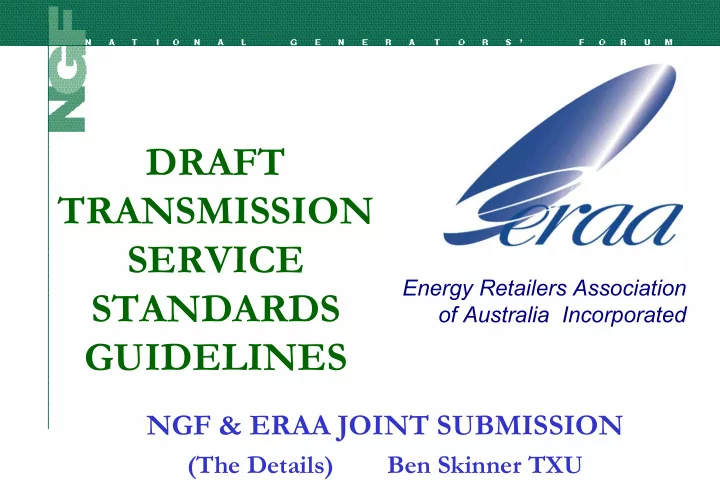

DRAFT TRANSMISSION SERVICE Energy Retailers Association STANDARDS of Australia Incorporated GUIDELINES NGF & ERAA JOINT SUBMISSION (The Details) Ben Skinner TXU 1
Summary • This presentation builds on 3 specific suggestions from participants : – “Peak-day” weighting of the standards – Publishing ratings “philosophies” – Publication of a simple “market impact” measure of constraints 2 Joint NGF and ERAA presentation
Need for Peak weighting • Most of the guidelines’ standards are simple time- weighted availability statistics – Encourages TNSP’s to minimise all outage times • But 95% of time, networks have large redundancy – Quick restoration provides no economic benefit • Incentive can be perverse: – Logistics cause longer outages off-peak – Rewards “breakdown” over “preventative” maintenance • Need to focus on the “5 percent” of system stress times 3 Joint NGF and ERAA presentation
How to Peak Weight? • Simple time/seasonal definitions not good enough – Most summer/winter workdays are mild, and networks are unstressed • Good opportunities to maintain & protect for extreme days • System Demand is a good, simple & objective surrogate for “network stress” – Probably <20 days (probably <10 in Vic/SA) where network is really stressed – Similarly these days tend to have big market impacts when transmission derated – All coincident with biggest 20 demand days 4 Joint NGF and ERAA presentation
Proposed Weighting • Circuit availability should only count on the highest 20 days of regional peak demand in the year. – The “peak days” are determined ex-post • Creates a big incentive to avoid/restore quickly during peak times – or to reschedule if conditions deteriorate • Ex-post so can never be certain: – TNSP must judge the risk in tomorrow’s weather forecast • Naturally incentivises reducing outages at all time, but particularly during unpredictable weather 5 Joint NGF and ERAA presentation
“Rating Philosophies” • Operating limits represent a risk/return trade off – The operating risk appetite should be taken into account when setting revenue – If TNSP’s have identical WACC, would expect to identically limits of identical assets • But examples show that is not always the case • Prescriptive harmonisation impractical • But benchmarking existing practice is . • At this time, we suggest only a process of transparency and education 6 Joint NGF and ERAA presentation
Setting Limits • A black art to participants – and presumably the ACCC! • Complex technical process of TNSP analysis & negotiations with NEMMCO – Due to differences in assets, topography etc., transmission limits necessarily vary • But there must be an underlying “philosophy” from which the TNSP assesses each piece of equipment 7 Joint NGF and ERAA presentation
Publication of Philosophy • A short document that describes how the TNSP approaches its limit setting, including policy for: – Identifying credible contingencies – Use of Emergency or short-term ratings, – Adjusting ratings with ambient conditions, • Can then convert the technical parameters of any plant into a NEMMCO constraint equation – Even participants could compare & contrast TNSP’s philosophies • Hopefully drives a culture of pride of best-practice in providing the most service from the least asset. 8 Joint NGF and ERAA presentation
Market Benefits • None of the Draft Guidelines’ measures, even when peak weighted, measures what regulated transmission actually produces: – The long-distance trading of electricity. • Guideline incentives can be perverse: – e.g. TNSP fixes minor lines first • We concur market based incentives very hard – We see no perfectly reliable and simple measures, so the proposal discussed here is again a publication tool only at this stage rather a than a financial arrangement. 9 Joint NGF and ERAA presentation
Market Impact measure suggestion • All “macro” elements of the transmission network have a nominal capacity – For inter-connectors provided in SRA info memorandum – For intra-connectors, is the “system normal” capacity from limits manuals. • All transmission capacities are represented by a constraint equation in the NEMDE – For each binding constraint there is a published “shadow price” • The improvement in total market trade (in $/MWh) if the constraint were released by one MW. 10 Joint NGF and ERAA presentation
Publishing market impact • Thus, we have publicly available the 2 key measures of the market impact of transmission limit reduction: – Reduction from nominal capacity in MW » multiplied by – Shadow price of binding constraint in $/MWh • Equals the impact of limit reduction on the market for that dispatch interval • We acknowledge, however, that the reduction may not be under the control of the TNSP – But we want the TNSP to think about the reduction and explain it. 11 Joint NGF and ERAA presentation
Publishing market impact • TNSP tracks all constraints applied to its network – When a the calculation from any one constraint exceeds $100k in one day: • Event published in a quarterly report • With explanation as to the TNSP’s view as to the cause – Interconnectors would be published by both TNSP’s – Reporting done by TNSP, not NEMMCO • To increase market understanding by TNSP’s • To educate the market as to what improvements are feasible 12 Joint NGF and ERAA presentation
In summary • ERAA/NGF submission supports ACCC’s desires, but wants to go further. • We sympathise that applying performance standards to regulated networks to achieve “market” objectives is difficult. – Therefore we have made constructive, detailed, suggestions: • Peak Weighting • Publication of “Rating Philosophy” • Publication of a Market Impact Event report 13 Joint NGF and ERAA presentation
DRAFT TRANSMISSION SERVICE Energy Retailers Association STANDARDS of Australia Incorporated GUIDELINES NGF & ERAA JOINT SUBMISSION 14
Recommend
More recommend